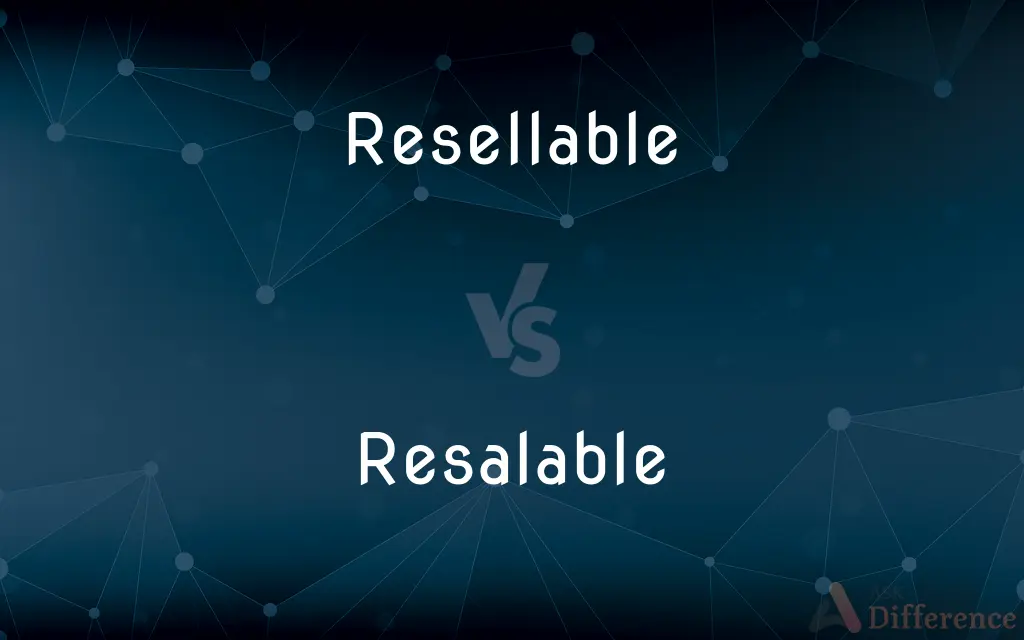Resellable vs. Resalable — What's the Difference?
By Urooj Arif & Fiza Rafique — Updated on March 6, 2024
Resellable and resalable both describe items that can be sold again, but resellable often implies a broader market appeal.

Difference Between Resellable and Resalable
Table of Contents
ADVERTISEMENT
Key Differences
Resellable is commonly used to describe items that retain enough value or interest to be sold again by the owner or a third party. Resalable, on the other hand, suggests that an item is in a condition or has characteristics that make it suitable for sale again, potentially including its original intended purpose or functionality.
While both terms indicate that an item can be sold again, resellable often carries a connotation of profitability or desirability in the secondary market. Conversely, resalable focuses more on the practical aspect of being able to sell an item again based on its condition rather than its desirability.
The distinction between the two terms can sometimes be subtle and context-dependent. In general, resellable might be used in contexts where the emphasis is on the item's appeal or potential for profit in the secondary market, whereas resalable might be chosen to highlight the item's condition and direct suitability for resale without necessarily implying high demand or extra value.
Comparison Chart
Focus
Market demand and desirability
Condition and suitability for sale
Implication
Potential profitability on secondary markets
Maintained quality and utility
ADVERTISEMENT
Usage Context
Limited editions, high-demand items
Returns in sellable condition, bulk goods
Connotation
Desirability, rarity, brand value
Practicality, condition, utility
Example
A resellable vintage watch
An unopened, resalable electronic device
Compare with Definitions
Resellable
Goods that are sought after for collection or investment purposes.
Certain artworks are resellable, appreciating in value over years.
Resalable
Items that can be sold again, typically because they are in their original, unopened condition.
Returned merchandise that is unopened and undamaged is considered resalable.
Resellable
Items that maintain or increase in value over time, making them desirable for resale.
Antique furniture is often considered resellable because of its craftsmanship.
Resalable
Goods that are capable of being returned to inventory and sold as new.
Overstocked items are often resalable if they remain in marketable condition.
Resellable
Merchandise that can be sold multiple times.
Resellable software licenses allow for transfer of ownership under specific conditions.
Resalable
Items that can be recycled or reused effectively in commerce.
Resalable packaging solutions are designed to reduce waste and support sustainability.
Resellable
Capable of being sold again, especially in the context of secondary markets.
The limited-edition sneakers are highly resellable due to their rarity.
Resalable
Products whose condition allows for resale without diminishing their original qualities.
Books that are kept in mint condition are resalable.
Resellable
Products that have a market demand that exceeds their initial sale periods.
Resellable tech gadgets often feature advanced technology or unique designs.
Resalable
Products that retain their value and functionality, making them suitable for resale.
Resalable electronic devices include those that have been refurbished to a like-new condition.
Resellable
Capable of being resold.
Resalable
The act of selling again.
Resalable
Capable of being resold.
Common Curiosities
Can an item be both resellable and resalable?
Yes, if it maintains its condition and also has a high demand in the secondary market.
How does the context affect the use of resellable vs. resalable?
The choice between the two terms depends on whether the emphasis is on the item's market appeal (resellable) or its condition (resalable).
Can all products be considered resalable?
Not all; only those in a suitable condition or with maintained utility and quality are considered resalable.
Is there a difference in profitability between resellable and resalable items?
Yes, resellable items often imply a higher potential for profitability due to demand, while resalable focuses on condition rather than profit.
Can digital products be resellable?
Yes, certain digital products like software licenses or digital art can be resellable under specific conditions.
Are resellable items always used?
Not necessarily; some new items are considered resellable due to their anticipated demand.
Is vintage clothing considered resellable or resalable?
Vintage clothing can be considered resellable due to its appeal and potential rarity value.
What makes an item resellable?
Items that have market demand, rarity, or brand value, making them desirable for secondary sales.
Why would a retailer care if an item is resalable?
Retailers value resalable items as they can be returned to inventory and sold again, minimizing loss.
What is the significance of branding in resellable items?
Branding can significantly increase an item's desirability and demand, making it more resellable.
What factors influence an item's resalability?
Factors include condition, original packaging, functionality, and current market demand.
What role does condition play in determining if an item is resalable?
Condition is crucial; items must be in a state that is acceptable for new customers.
How does technology impact the resellability of products?
Technological advancements can increase a product's desirability, making it more resellable, especially if it's cutting-edge or innovative.
How does sustainability relate to resalable products?
Resalable products support sustainability by reducing waste through reuse and recycling.
Do consumer rights affect the resalability of products?
Yes, consumer rights regarding returns and exchanges can impact which products are considered resalable.
Share Your Discovery

Previous Comparison
Liniment vs. Ointment
Next Comparison
So vs. SooAuthor Spotlight
Written by
Urooj ArifUrooj is a skilled content writer at Ask Difference, known for her exceptional ability to simplify complex topics into engaging and informative content. With a passion for research and a flair for clear, concise writing, she consistently delivers articles that resonate with our diverse audience.
Co-written by
Fiza RafiqueFiza Rafique is a skilled content writer at AskDifference.com, where she meticulously refines and enhances written pieces. Drawing from her vast editorial expertise, Fiza ensures clarity, accuracy, and precision in every article. Passionate about language, she continually seeks to elevate the quality of content for readers worldwide.














































